Congee, nai cha, and me
by Patrick – 12 great comments. Room for one more!
Aha! I finally figured out why the smell of frying food conjures up such strong feelings of summer. And it isn’t all funnel cakes either.
The whole synesthetic experience must’ve started when I was still doing my ex-pat thing overseas. It was on the tropical island of Taiwan where winter temperatures hardly dipped below 10 Celsius (50 Fahrenheit), and the summers we non-stop steam baths regularly hitting 40 Celsius (104 Fahrenheit), that I first made the association. After a few years of that, the link between summer heat and fried food musta just burned into my brain, I guess.
The fried food part of the equation is my favourite Taiwanese breakfast, usually eaten in small roadside shops surrounded by greasy steam and greasier customers.
The three most common meals at such establishment are, as I recall, lobogau, diced fried daikon (giant white radish), congee, a cold soup consisting of rice, some kind of shredded meat, and a variety of veggie / nut toppings, and dan bing, which I’ll be discussing here and the only thing that I actually enjoyed in the mornings. (Fried radish — gross!)
The name dan bing comes from the Mandarin words “ji dan” (chicken eggs), and “bing” (platter or plate – or ice if mispronounced). It’s usually accompanied by “nai cha”, literally “milk tea”, but with whitener being used instead of real milk — for a variety of reasons. Incidentally, this is also the secret ingredient in Tea Shop 168’s milk teas, unsurprisingly since this is also a Taiwanese company. (With tapioca in the milk tea — buble milk tea — it’s called “jinju nai cha”.)
Dan bing is super easy to make:
The “oriental pancake”, the bing, is something like a crepe. It’s made of wheat, rice flour, sesame, and occasionally sprinkled with sesame seeds (yum); pretty simple but I’ve never had the patience to try to make it by hand. Especially since a package so cheap at T&T.
Besides this, you’ll need the ji dan, of course, a little oil, and soya paste.
Now this last ingredient is extremely important. Don’t use soya sauce – it’ll taste awful. Soya paste is sweeter, less salty, and dip-compatible. There are many soya sauces and glazes available; you probably won’t go wrong with most of them but the fewer the ingredients on the label, the more authentic it’ll be:
Also, I’d recommend not using anything fermented – it’s an acquired taste.
So from here on in we’re cooking Chinese breakfast nook style – fast and furious. Heat up that pan, toss a bit of oil in, and throw in a scrambled ji dan:
While dancing and gyrating wildly, throw your bing in the air, then toss it like you just don’t care. On the pan. The dancing / gyrating motions aren’t entirely necessary but the meal won’t be nearly as elaborate without them.
You’ll want the bing to stick to the ji dan so don’t use too much oil, and make sure the ji dan is still a bit runny before throwing the pancake on top.
Cook for a few seconds until the two are stuck together, or the bing has achieved old people skin consistency, then flip over and cook the other side. Not too much – you now have to roll it into a tube so it must remain flexible.
Once you’ve got your dan bing rolls, simply chop them up into bite-sized pieces with the spatula – it’s a chopstick meal – and drizzle with sauce. Or dip. Whatever turns you on.
I find that two dan bings usually do the job for me in the morning, and I can typically go from raw ingredients to my belly in under five minutes. Fast, simple, tasty food that bears an overbearing olfactory resemblance to tropical summers. And the name is fun to say too. :)


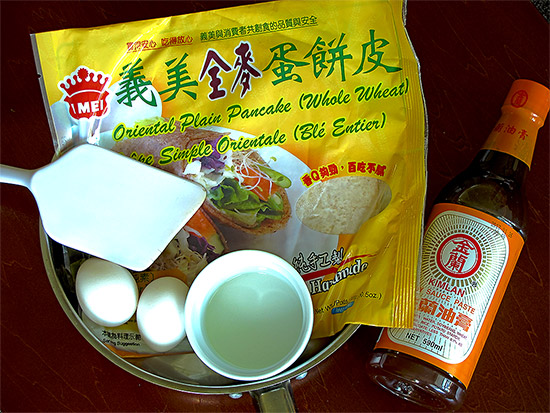
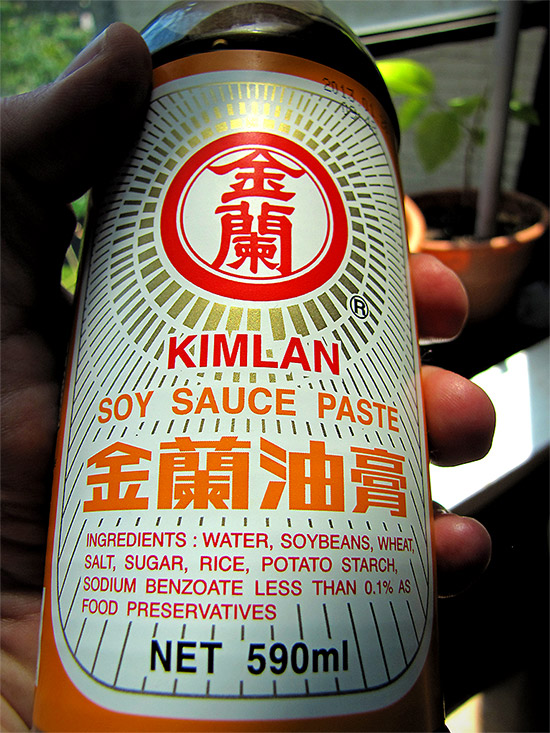
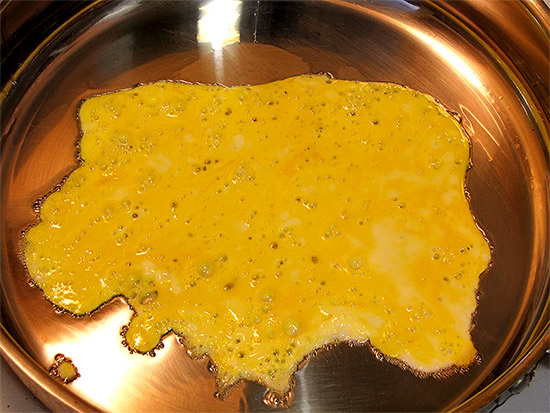
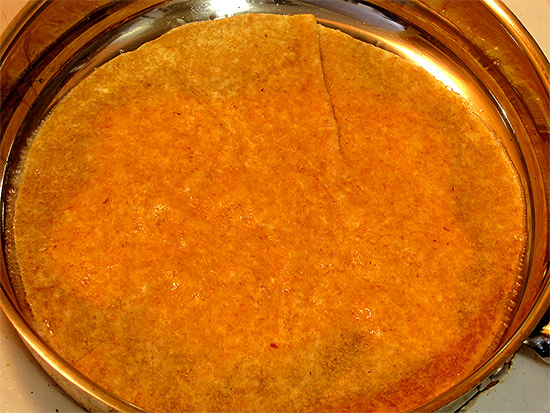
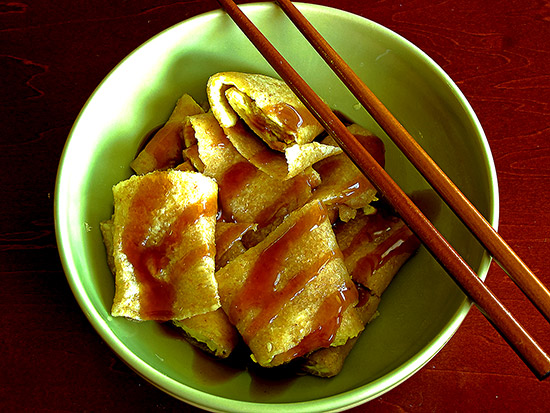


May 21st, 2010 4:34 am
great blog u have here. Please take the time to visit mine too, let's follow each other
May 21st, 2010 5:50 am
Thanks Arkanoid Legend, but I only follow blogs that produce their own content. Thanks for dropping by. :)
May 21st, 2010 4:47 am
i love congee too
May 21st, 2010 5:50 am
I'm not sold on Congee, Melds. Some variations are tasty but other ones … blech. :)
May 21st, 2010 10:27 am
Hate to be critical but that new girl's posts are annoying – I have learned to skip them. And the new guy isn't holding my attention either.
On the other hand I love the "Toronto Photo 365" site.
May 21st, 2010 12:26 pm
Be as critical as you like, Grace. Some people don't like what I do either, and to be perfectly honest, the first three months of Toronto City Life's existence were JUST AWFUL! Live and learn. :)
The point of TCL is to put a window on life in the city of Toronto in all its aspects. Some like certain aspects, some like others. I think that's perfectly normal and it's why I'm trying to get new people to contribute.
However, I am in the process of creating author list pages so that you can filter posts by individual authors, and I'm still actively hunting for more contributors. (Plus I'm now posting more than ever.)
That all being said, if you think the contributors' content has potential but their style or approach needs work, by all means leave some constructive criticism and let them know how they could improve. I warned them all that they'd be "exposed" so they should be mostly prepared for it.
I'm taking a very hands-off approach with contributors unless I'm asked because, and I'm being *totally* honest, I see every one of the contributors as having talent and great potential. Sometimes that potential may still need to be realized, but it's there. If you think I have a good critical eye for writing and photography, I hope you trust me here too. :)
And thanks! (re: "Toronto Photo 365" ) This is one of my satellite sites that I'm using to get a bit more mileage from old TCL photos. If you like the photos here, chances are pretty good you'll like them there too. :)
May 21st, 2010 1:00 pm
Since I am Asian, I love Asian food . Aside from my own Filipino, I love Chinese, Thai and Vietnamese cuisine….they're so yummy.
The pictures you have here are so tempting…..mmmmm.
August 28th, 2010 11:59 pm
thanks ive been looking for a recipe for dan bing and have been searching for a while! i appreciate the simplicity of yours and will try it out, but i will probably look for more of a hand made situation. thanks agian!
August 30th, 2010 10:22 am
The only thing I haven't been able to do, Anonymous, is the pancake portion by hand. The ingredients on the package seem simple enough but the few times I've tried to replicate it, it's gone wrong.
November 5th, 2011 1:05 am
I love naicha… We buy it here at a local chinese fastfood store Chowking.. I would love to have the recipe for that, so I can make it at home and not need to go to Chowking for a small glass, coz they don’t serve it any bigger…
LOL
July 7th, 2013 2:55 am
Do you know a good milk tea recipe? I was looking for one but I can’t seem to find a good one.
July 9th, 2013 12:14 pm
Well, Sales Associate, assuming that is your real name, it’s a good question, even if you are here just for spammy purposes.
Asian milk tea is traditionally made with tea powder, whitener, and fructose (or sugar). This may not sound traditional at all, but here’s why it is:
The concoction comes form tropical countries. I first tried it in Taiwan, but I’m sure the recipe isn’t far off most places in the Pacific. Because of the heat (and spoilage), milk is not as good as dehydrated milk or whitener to keep around. Tea powder is used because Asian milk tea is often a roadside drink — pull up on your bike/scooter, grab one, ride off. In other words, it needs to mix fast.
It’s not exactly what the British would call a milk tea, but necessity is the mother of invention and Asian milk tea has a unique and not unpleasant taste. Plus, in it’s most common form it’s lactose free, a fact that is also responsible for some interesting flavour combinations.